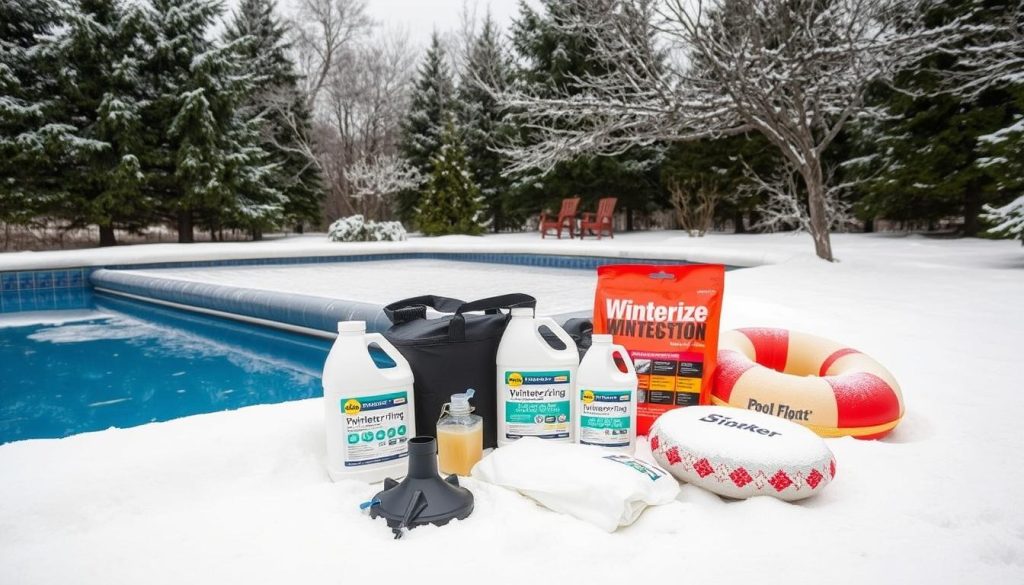
Installing a pool cover takes only a few hours. It’s crucial for winterizing and protecting your pool from debris and accidents. Halogen Supply offers high-quality covers for inground and above-ground pools.
Covering your pool for winter is vital for maintenance and preventing cracks. Keep residential pool supplies handy during the cold months. Our covers provide optimal protection with 10 to 15-inch overlaps for a secure fit.
Preparing Your Pool for Winter
Winterizing your pool protects your investment and readies it for next season. The process involves lowering water levels, cleaning, and gathering supplies. These steps prevent damage and save time and money in spring.

Lowering the Water Level
Lower the water level to about 15 cm below the return pipe. This prevents damage to the pool liner when water freezes. Wait until water temperature falls below 10 degrees Celsius before closing your pool.
Cleaning the Pool
Thoroughly clean your pool before covering it for winter. Adjust the pH level to between 7.0 and 7.2 to prevent damage. Maintain chlorine content at 1-3 mg/l after adjusting the pH.
Remove debris like leaves and twigs from the water. Check for holes in the pool liner, as even small ones can cause damage.
Gathering Necessary Supplies
To winterize your pool, you’ll need these supplies:
- Winter pool cover
- Winter floats or air pillows
- WinterCare or similar winterizing substance
- Pool cover pump
- Leaf net (for above ground pools)
Remove all accessories, such as ladders, and store them in a frost-free location. Place winter floats in the pool before applying the cover to reduce ice damage.
For above ground pools, inflate air pillows to cover about 10% of the surface area. This helps manage water expansion when frozen.
| Pool Type | Recommended Winterizing Steps |
|---|---|
| In-ground Pool | Lower water level, clean pool, adjust pH and chlorine, remove accessories, apply winter floats and cover |
| Above Ground Pool | Lower water level, clean pool, adjust pH and chlorine, remove accessories, inflate air pillows, apply leaf net and winter cover |
Following these steps and using the right supplies ensures proper winter preparation. Your pool will be protected, making spring opening much easier.
Choosing the Right Pool Cover
Selecting a pool cover involves considering pool type, climate, and desired protection level. Various cover types are available to suit different needs. Let’s explore the options to help make an informed decision.
Leaf Nets
Leaf nets keep leaves and debris out of pools. They’re lightweight and easy to install, making them popular for above-ground pools. These covers often pair with other types for added protection.
Standard Covers
Standard pool covers offer better protection against debris and animals. They’re still light enough for one person to handle. These covers come in mesh and solid materials.
Safety Covers
Safety covers provide top-notch protection for all pool types. They support people and animals, preventing accidental drowning. Two main types exist: mesh and solid.
| Cover Type | Pros | Cons |
|---|---|---|
| Mesh Safety Cover |
|
|
| Solid Safety Cover |
|
|
Safety mesh pool covers have been demonstrated to hold the weight of elephants, prevent automobiles from sinking, and save animals and children from drowning.
Pool size, shape, and water features are key factors in choosing a cover. Custom-made covers may be needed for unique pool shapes. Consulting a pool pro helps select the right material and fit.
Step-by-Step Guide: how to put pool cover on
Installing a pool cover keeps your pool clean and lasting longer. You can do it yourself with the right tools and a bit of patience. Let’s look at two ways to secure your pool cover: the pole method and the hanger method.
The Pole Method
Start by laying the cover flat next to the pool. Attach a long pole to one edge using zip ties or rope. With a partner, lift the cover onto the pool.
Pull it forward and switch sides until it’s fully extended. Make sure the cover is even and secure to keep debris out of the pool.
The Hanger Method
Use clamp-style coat hangers to secure the cover’s edge to the pool’s edge. Run the hanger behind the pool’s pole supports. Once in place, secure the cover with ties and remove the hangers.
Adjust the cover to make it even all around the pool. Tuck in extra material to stop wind from getting underneath. This method works well for a more secure fit.
A well-installed pool cover helps your pool last longer. It stops evaporation, keeps out debris, and maintains water warmth. Taking time to install it right is key to responsible pool ownership.







